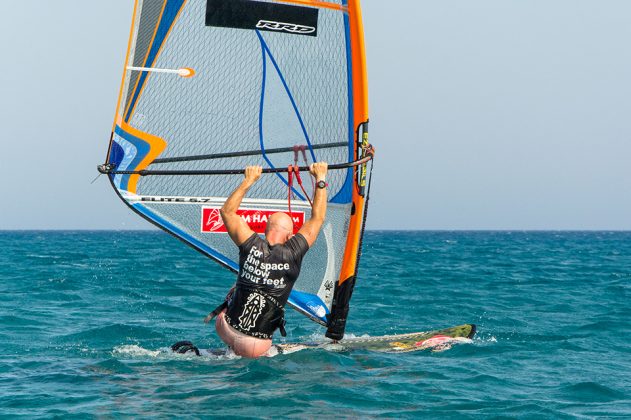JEM HALL
MOVE ON UP – WINDSURFING TECHNIQUE
WATERSTART
The waterstart is a gateway move and hugely important for smooth progression through our great sport.
Words Jem Hall // Photo Nicolas Jones
www.jemhall.com
(This feature originally appeared in the August 2017 issue of Windsurf Magazine. To read more features like this first, Print and Digital subscriptions are available.
Prices include delivery globally for 10 x issues a year!)
When coaching I notice with my intermediates that the order of either learning footstraps / harness or waterstarting is different for everyone. I feel the waterstart is best learnt early as it teaches you great habits, builds on brilliant beach starts and gives you more energy to crack the harder stuff and accelerates progress in planing winds. You have to consciously go out there and learn it or improve it. Advanced sailors should also be improving their waterstarts as it means they will stay out longer when gusty and will also have more confidence to do both float and ride and light / medium wind fundamentals.
“ The waterstart is best learnt early as it teaches you great habits. ”
The Hangover
I often say on my clinics that how we gybe is how we (wave) ride and there is also a strong parallel from our beach start technique to our performance in waterstarting.
The main hangovers from bad beach starts that will deny you smooth waterstarts are:
• Gear gazing: this is looking at the rig whilst waiting to get up and away. This often results in the board bearing away too much and you get pulled over or you miss changes in wind strength and the sail may dump on your head.
• Poor steering: this can stem from the former or just not understanding how to steer the kit with good vision and boom leverage. You need to twist the handlebars (boom) and look where you want the gear to turn.
• Back leg blunders: this can be too straight a back leg (board turns into the wind) or poorly placed whereby it will hinder board steering and control.
• Licking the boom: now we are moving into getting on the board and here if we hold the boom too close we will have less rig power as we move out of the water and the result will be falling back to our starting point.
• Timing: this may be pulling in with the back leg and pausing too long before throwing the boom and following, or twisting the rig without pulling in on the back leg.
• Up and off: this is where you actually make it up on to the board and then catapult as you have not opened the sail and looked upwind after your arrival.
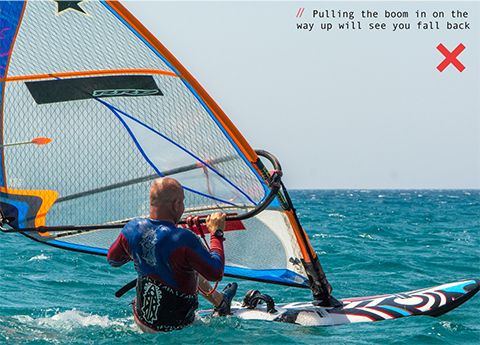


The cures and drills for the above ills in the beach start are:
• Hands near the lines: this will help you steer subtly, control power and then it will produce more power in the sail as you move up and away.
• Spend time steering and controlling the rig in the beach start position. This will teach you great habits and also help you develop power control of the rig too.
• Active back leg: understand how important it is as you bend it and hold position and both steer and control power well. You should actually have a slight bend in it as you are about to go up and then it should be really bent in the up and away process.
• Heel down: your back leg should have the heel down and toes up and it should be just upwind of your centreline and midway between the footstraps.
• Explode and power up: pull in hard on the back leg and extend your arms as your head eats the mast foot.
• Easy on the front leg: do not rush to place your front leg on the board. If you are really keen to nail the waterstart then doing a beach start (both ways) with a leg drag will really build skills.
• Look upwind after starting: once you get up, open the sail, keep low and be ready for powering up.
Rig clearance
How you handle the rig and clear it starts in with your kit carrying and beach start habits. You should always be looking to work with the wind, therefore I suggest you know how to flip a rig on the beach so you can walk with it in either direction with the wind flowing under the sail. After launching always look to draw the rig across you with your hand on the mast. Moving forward from this, learn to gybe the board with the rig and turn it around whilst moving your feet around the bottom accordingly and how / when your hands move from boom to mast and back to boom. This will help you gybe the board in the waterstart position so you can go in the opposite direction to how you have cleared the rig.
The main tips for clearing the rig are:
• Relax and assess the wind direction.
• Ensure your mast is 90 degrees to the wind.
• In certain positions, swim towards the wind to get water off the sail and draw the wind under it.
• Hold the mast higher up the sail for lighter winds or bigger sails.
• Draw the rig across and up at an angle of about 30 degrees to the wind so you are using the wind and not using too much muscle.
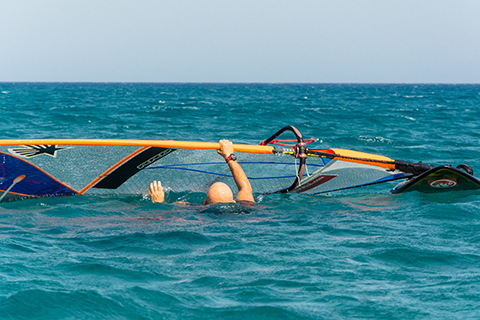
1.Swim backwards with the sail, either with 2 hands or 1 on the mast above the boom. Ensure you are at the right angle to the wind. When you can see the water come off the sail, draw the sail across and up to clear it as you keep swimming.
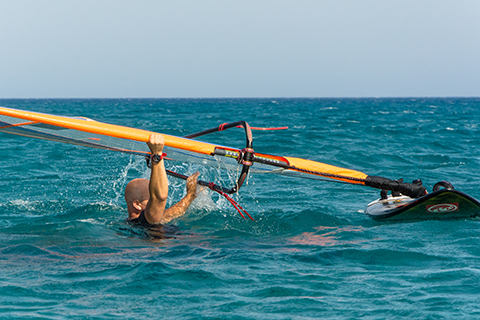
2. Continue to draw the rig across with your front arm as you twist to look upwind and face the boom. Put your back hand on the boom near the harness line.
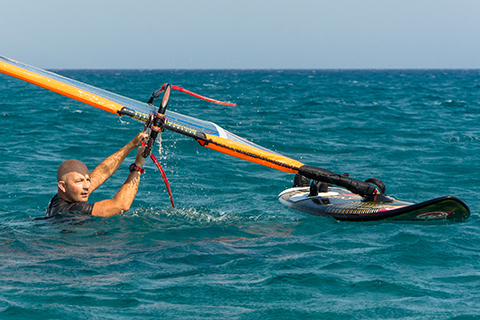
3. Keep an eye on the wind as you begin to steer the board to across the wind. Move the rig up if the wind is lighter, hold it down lower if it is windier.
Kit and Conditions
Board size and sail size are important for slick starts. Avoid too much volume as these boards sit too high in the water, yet do not go too small so that you know you can uphaul and come home.
The sail size should have good power but not be too big. Too small a sail will not provide enough power and too big a sail will be hard to clear from the water. For most sailors, 110 – 140 litre boards and sails from 4.2 to 6.2 are a good size guide.
Optimum wind strengths are not mega windy or too light; 12 to 25 knots is ideal.
Stall to Start
I will now highlight again the key tips to the waterstart and I suggest you have a really good look at the pics and understand them as you visualize yourself in these positions.
• Lounging in the sweet spot: after clearing the rig, look upwind and know your position and see the wind. Wait in position if the wind is too light or strong. This waiting position is a good distance from the tail of the board and with your hips and shoulders parallel to the boom.
• Ready to go: get your back foot on (heel down) in the right place! Leave your front leg off and hanging down, this will be both your daggerboard and propeller i.e. it will kick as you move up to assist you.
• Up and away: extend arms to catch the wind as you twist the rig and pull your back heel to your arse. Think eat (mastfoot) and bend (back leg) and then as your rig nears upright, go for the mantra of ‘extend (arms) and bend (back leg).’ And oh yes, kick really hard with the front leg!
• Come up slow and stay low once upon the board. You can actually plane out of a waterstart.
• Sheet out: to avoid catapults, sheet out once upright.
• Relax: it might take a few goes at the up and away process but know that you can and will get on the board.
Physicality
You will need leg and hip flexibility, mobility and strength to do all starts smoothly, especially in the hamstrings (back of leg) and hips.
Independent leg strength is strongly recommended so your starts are good both ways. Step-ups, lunges and walking lunges are great exercises for these.
A good power to weight ratio helps us in all areas of windsurfing.
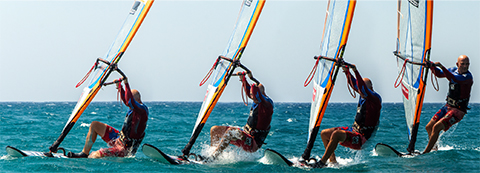
1.Twist arms to power the rig up as you pull in on the back leg. Your head will have been aiming to eat the mastfoot prior to this. Kick hard with your front leg, hanging down in the water.
2.Maintain the back leg bend with the heel pulling the tail upwind. Wait until the rig is almost upright before placing your front foot on the board. Come up underneath the boom and pull down (not back) on it.
3.Come up slow and stay low, still pulling down on the boom and still with a bent back leg.
4.Sheet out and look upwind to assess whether to sail upwind (chug) or bear away and get planing.
RRD boards, wetsuits, softwear, Ezzy sails and Pro Sport Sunblock sponsor Jem Hall. Get him live and direct on one of his highly acclaimed coaching holidays but be quick as they are selling out – check out his fab site www.jemhall.com for details. You can also follow him on twitter / Facebook / Instagram.

